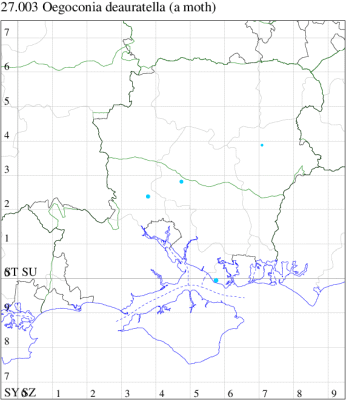2020 Annual Report for: Autostichidae / Symmocinae
For species seen in 2020 that had less than or equal to 100 records, full details are included; for more common species, the earliest, latest and highest count by vice-county are shown. The narrative for each species is taken from the main Hantsmoths website, and it is possible that some information on abundance and occurrence can get out of date, as it is impossible to keep up with all changes; however it should give a good introduction to each species. The tables in each species account summarise the previous status, and that for the current year.
For the maps, all records prior to 2020 are shown by a blue dot (the larger the dot, the more recent), with the current year's records shown in red. As previous records are superimposed on any report for 2020, new sites have greater emphasis (i.e. will show as 'more red').
In the species accounts, an asterisk next to a location indicates a new 10km square record; earliest ever dates are highlighted in orange, and latest ever in red. Initials in the species accounts refer to the recorders listed here. Please get in touch if you identify any omissions or errors, in particular if you have records that have yet to be submitted. Details of how to submit records can be found here.
27.001 [B&F: 0870] Oegoconia quadripuncta (Haworth, 1828) - Common
Common in hedgerows and woodland throughout much of southern England and southern Wales, with records north to Lancashire; rare in Ireland. In Hampshire and on the Isle of Wight of those Oegoconia specimens that have been so analysed, all but one have proved to be the present species. The genus is probably under-recorded, but can be locally common. Wingspan 13-16 mm. Species of Oegoconia can only be reliably identified by genitalic examination. Larva feeds on leaf litter and decaying vegetable matter.
Records prior to 2020
| Vice County | #Records | #Individuals | First Record | Last Record |
|---|---|---|---|---|
| 10 | 57 | 65 | 1975 | 2019 |
| 11 | 981 | 1352 | 1975 | 2019 |
| 12 | 195 | 240 | 1993 | 2019 |
2020 records
| Vice County | #Records | #Individuals | Max Quantity |
|---|---|---|---|
| 10 | 9 | 12 | 3 |
| 11 | 90 | 134 | 6 |
| 12 | 20 | 35 | 5 |

Records by year
Records by week (adult)
Records by week (larval)
Record Summary
VC10: Earliest: Parkhurst Forest, 29 Jun, 1 (IOu) Latest: Haseley Manor, 11 Aug, 1 (IOu) Max count: Shanklin, 30 Jul, 3 (IOu)
VC11: Earliest: Fareham, 15 Jun, 1 (MLO) Latest: Eastleigh, 18 Aug, 1 (KArb) Max count: Totton, 17 Jul, 6 (LH)
VC12: Earliest: Farnborough, 25 Jun, 2 (KBW) Latest: Harestock, 18 Aug, 1 (GRog) Max count: Farnborough, 23 Jul, 5 (KBW)
27.003 [B&F: 0871] Oegoconia deauratella (Herrich-Schäffer, 1854) - Local
Local in hedgerows and woodland throughout much of south-eastern England. Recorded for the first time in Hampshire at Farnborough on 10 June 1993. Not recorded from the Isle of Wight to date. Wingspan 11-15 mm. Can only reliably be separated from O. quadripuncta by dissection of the genitalia, but in O. deauratella median fascia usually less than one-third of wing-width broad, and in O. quadripuncta this fascia often sinuous and obsolete on dorsum (MBGBI Vol 4 part 1). Larva feeds on leaf litter and decaying vegetable matter.
Records prior to 2020
| Vice County | #Records | #Individuals | First Record | Last Record |
|---|---|---|---|---|
| 11 | 4 | 5 | 2013 | 2019 |
| 12 | 3 | 3 | 1993 | 2007 |
2020 records
| Vice County | #Records | #Individuals | Max Quantity |
|---|

Records by year
Records by week (adult)
Records by week (larval)
Record Details
VC11: Eastleigh, one, to actinic, 02 Aug (KArb)